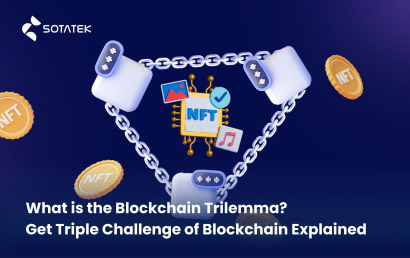Blockchain technology has transcended its early reputation as a cryptocurrency enabler to become a strategic pillar for innovation. As industries grapple with digital transformation, blockchain’s decentralized architecture, cryptographic security, and transparent governance are redefining how businesses operate, collaborate, and compete. This blog delves into the nuanced shifts driving blockchain adoption, explores its long-term implications, and underscores how tailored IT solutions can unlock its full potential for enterprises.
- gsdgs
- dsfds
- ihkuk
Blockchain technology has transcended its early reputation as a cryptocurrency enabler to become a strategic pillar for innovation. As industries grapple with digital transformation, blockchain’s decentralized architecture, cryptographic security, and transparent governance are redefining how businesses operate, collaborate, and compete. This blog delves into the nuanced shifts driving blockchain adoption, explores its long-term implications, and underscores how tailored IT solutions can unlock its full potential for enterprises.
Nhập tiêu đề... thẻ h
Blockchain technology has transcended its early reputation as a cryptocurrency enabler to become a strategic pillar for innovation. As industries grapple with digital transformation, blockchain’s decentralized architecture, cryptographic security, and transparent governance are redefining how businesses operate, collaborate, and compete. This blog delves into the nuanced shifts driving blockchain adoption, explores its long-term implications, and underscores how tailored IT solutions can unlock its full potential for enterprises.
The Evolution of Blockchain: From Disruption to Strategic Imperativadada
Blockchain is no longer a novelty, it’s a necessity. At its essence, blockchain solves a fundamental problem of the digital age: trust. Decentralizing data storage and automating verification through consensus algorithms eliminates reliance on intermediaries while ensuring transparency. For businesses, this translates to reduced operational friction, enhanced security, and new revenue streams.
this translates to reduced operational friction, enhanced security, and new revenue streams.
Consider the global supply chain crisis: Blockchain’s ability to provide end-to-end visibility has become a lifeline. Retail giant Walmart, for instance, reduced food traceability time from 7 days to 2 seconds using blockchain, mitigating risks of contamination and recalls. Similarly, Maersk’s TradeLens platform digitizes shipping workflows, cutting documentation delays by 40%. These examples highlight blockchain’s role as an operational backbone rather than a speculative experiment.
However, blockchain’s value extends beyond efficiency. It’s reshaping business models. Tokenization - the process of converting assets into digital tokens is democratizing access to investments. Real estate, art, and even intellectual property are now fractionalized, enabling micro-investments and liquidity in traditionally illiquid markets. This shift is redefining ownership and creating ecosystems where value flows more freely.
Strategic Trends Redefining Blockchain’s Trajectory

Blockchain’s promise is tempered by three systemic challenges:
1. Decentralized Finance (DeFi): Rewiring Global Finance
DeFi has evolved from a niche experiment to a $100B+ ecosystem, challenging traditional banking’s monopoly. Unlike conventional finance, DeFi platforms operate on open-source protocols, allowing anyone with an internet connection to lend, borrow, or trade assets. Aave and Compound, for example, facilitate algorithmic lending without credit checks, appealing to the 1.7 billion unbanked adults globally.
But DeFi’s real disruption lies in programmable money. Smart contracts automate complex transactions such as insurance payouts triggered by real-world events (e.g., flight delays), reducing administrative overhead. Yet, challenges persist:
- Regulatory gray areas: Governments struggle to classify DeFi platforms, creating compliance risks.
Security flaws: Over $3B was lost to DeFi hacks in 2023, often due to smart contract vulnerabilities.
Strategic Insight: DeFi’s future hinges on hybrid models that merge decentralization with regulatory compliance. IT solutions that embed KYC/AML protocols into DeFi platforms or offer auditing tools for smart contracts will bridge this gap.

123
2. CBDCs: Governments Embrace Digital Sovereignty
Central Bank Digital Currencies (CBDCs) represent a paradigm shift in monetary policy. Unlike cryptocurrencies, CBDCs are state-backed, programmable, and designed to coexist with cash. China’s digital yuan, already used by 260 million citizens, exemplifies this shift. The EU’s digital euro-pilot aims to combat fraud and streamline cross-border payments, which cost businesses $120B annually in fees.
CBDCs also enable targeted fiscal policies. For instance, stimulus funds can be programmed to expire if unspent, ensuring timely economic boosts. However, privacy concerns loom large. The digital yuan’s traceability raises questions about state surveillance, while the EU’s proposal for anonymous “digital cash” balances transparency with individual rights.
Strategic Insight: Businesses must prepare for a hybrid financial landscape. IT solutions that integrate CBDCs with existing payment gateways or develop privacy-preserving digital wallets will be critical.
3. Sustainability: Blockchain’s Green Pivot
Blockchain’s energy consumption has drawn criticism, but the narrative is shifting. Ethereum’s Merge to Proof-of-Stake (PoS) slashed its carbon footprint by 99.95%, aligning with global net-zero goals. Beyond consensus mechanisms, blockchain is becoming a tool for sustainability:
- Carbon credit trading: Platforms like Toucan Protocol tokenize carbon offsets, enabling transparent trading.
- Ethical supply chains: BMW uses blockchain to trace cobalt in EV batteries, ensuring no child labor is involved.
Strategic Insight: Sustainability is now a competitive differentiator. IT solutions that design energy-efficient blockchains or integrate ESG (Environmental, Social, Governance) tracking into enterprise systems will attract stakeholders to prioritize ethical practices.
4. Enterprise Blockchain: Beyond Pilots to Core Infrastructure
Enterprises are moving from proof-of-concepts to production-grade blockchain deployments. Key drivers include:
- Supply chain resilience: De Beers tracks diamonds from mine to retail, reducing conflict mineral risks.
- Healthcare Interoperability: Estonia’s blockchain-based health registry allows secure data sharing across 1,000+ providers.
Yet, integration remains a hurdle. Legacy systems often lack APIs compatible with blockchain networks, and siloed data undermines transparency.
Strategic Insight: Blockchain-as-a-Service (BaaS) platforms, like Microsoft Azure’s offering, abstract technical complexities, allowing enterprises to focus on use cases. IT providers that offer modular, interoperable solutions will lead this space.
Read more: Blockchain Development
Overcoming Adoption Barriers: The IT Imperative

Blockchain’s promise is tempered by three systemic challenges:
- Interoperability: Most blockchains operate in isolation. Cross-chain platforms like Polkadot and Cosmos are solving this, but businesses need middleware to unify disparate systems.
- Regulatory Complexity: GDPR’s “right to be forgotten” clashes with blockchain’s immutability. Solutions like zero-knowledge proofs (ZKPs) enable data verification without exposing sensitive details.
- Talent Gap: 58% of firms cite a lack of blockchain expertise as a barrier. Upskilling programs and no-code blockchain tools are essential for scaling adoption.
Strategic Insight: IT solutions must address these pain points holistically. For example, hybrid blockchains that balance public transparency with private control can satisfy compliance needs, while low-code platforms democratize development.
The Path Forward: Integrating Blockchain into Business Strategy
Blockchain isn’t a standalone solution, it’s a strategic enabler. Businesses must align blockchain initiatives with core objectives:
- Cost reduction: Automate manual processes (e.g., invoice reconciliation) via smart contracts.
- Revenue growth: Monetize data through tokenized marketplaces or decentralized apps (dApps).
- Risk mitigation: Use blockchain for fraud-resistant audits or real-time compliance monitoring.
For instance, J.P. Morgan’s Onyx network processes $1B daily in blockchain-based transactions, slashing settlement times and errors. Similarly, Salesforce’s NFT Cloud lets brands tokenize customer experiences, fostering loyalty in Web3 ecosystems.
Blockchain as a Catalyst for Long-Term Value
The blockchain revolution is not about replacing existing systems but augmenting them. Its true power lies in fostering trust in a fragmented digital world—whether through tamper-proof supply chains, inclusive financial systems, or sustainable business practices.
For enterprises, the question isn’t if to adopt blockchain, but how. Success requires:
- Strategic vision: Prioritize use cases aligned with business goals.
- Collaboration: Partner with IT experts to navigate technical and regulatory landscapes.
- Agility: Continuously adapt as blockchain standards evolve.
test ul li
- 1
- 2
- 3
The future belongs to businesses that treat blockchain not as a technology project, but as a cornerstone of their digital transformation strategy.









